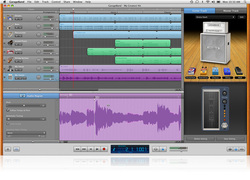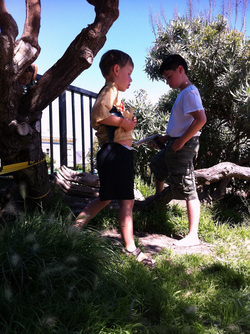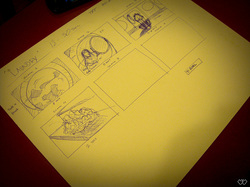 Garage Band has various features that I found exciting and useful. With some simple instruction, students will enjoy recording and manipulating their voices. I like the simplicity of creating new tracks, splitting audio clips, and adding effects. I am not sure how much i enjoy the feature of adding pictures and video. If one has Garage Band, they likely have iMovie. iMovie is much more efficient and useful when adding visual aspect to a project.
Of all the picture apps explored, I found PhotoFunia to be the most entertaining, easy to use, and full of effects. I was familiar with many of the apps covered in this session, but it was fun to see them from the student/teacher's perspective. The apps covered in this short class included: Instagram, Camera +, Frame Magic, Aviary, BeFunky, Adobe Photoshop Express, PhotoFunia, Space Paint, Color Effects, Pixlr Express.
We spent the rest of the instruction period, prior to lunch, working on writing scripts for our digital story. I feel that scripts can be very useful, and in the long run, save time. This is especially the case with larger scale movies and plays. When students begin writing and recording their movies and projects, having a script will make the story more cohesive, understandable, and they will stay focused while working.
Living in the Story and Unfolding Lessons Learned. If either of these two elements is missing, you likely are viewing a great digital story... but not storytelling.
Read more: http://creativeeducator.tech4learning.com/v04/articles/The_Art_of_Digital_Storytelling#ixzz2aYGNfHWh
Living the Story
It is all about the connection with the audience. It is vital to make the story personable and "sticky" so they will remember it. Knowing what will capture one's attention, keep their attention, and and enthrall them in your story is the trick to storytelling. The more they can relate to the story, the more they will enjoy listening and staying engaged.
Unfolding Lessons Learned
So what? That is a question you never want the audience to ask while your telling a story. If they don't follow the story because they can't relate or difficulty in following the storyline. When one looks for a moral of the story it is basically asking them, what does it mean, how will this relate to me, how can i implement the lesson learned into my life. It is good to let the listeners find deeper meaning on there own, but the basic theme or lesson of the story should be plain and clearly stated. In the recent film, Lincoln, (which I would not recommend starting at 10:30 pm) had several examples of great story telling. Daniel Day-Lewis portrayed President Lincoln, and shared stories throughout the entire film utilizing the talents of Living the Story and Unfolding Lessons Learned.
3 forms of Digital Storytelling in the classroom As for students using digital storytelling, there are various programs and projects that they can use.
1) Comic Life is a great way to storyboard their various projects when digital storyboarding is used. If they are creating a project for a book report, they can use this as a guide or an actual report. This is also a great way to do a digital concept map. Social studies is often given the backseat due to time and core tested subjects. This is a slick way to take social studies and incorporate digital/technological topics.
2) Writing screen plays and short stories and creating a movie through iMovie. This is more complicated, but once you utilize this program and become familiar with it's functions, it is an invaluable tool to create different movies. You can utilize this with Comic Life, time lapses, and stop motion animation. It ties everything together and creates a fluid/watchable product. It also gives you the opportunity to create storyboarding within the movie. Along with movies, the trailer format is great for small projects.
3) iMotion is a FREE (I repeat, FREE) app that is easy to use and produces great productions... pending on the imagination, ingenuity and work of the user. As a class, we used pipe cleaners to create a stop-motion animated flick. One of the best aspects to the iMotion, is the ability to use another device as a remote to take pictures. This is incredibly useful when working with in a group. This can be used with, social studies, language arts, and even math. I thought that giving the students the opportunity to create stop motion movies with math manipulatives could be incredibly fun and informational.
 Monitoring and stopping cyber-bullying appears to be a daunting and overwhelming task. With the digital/technological age in most aspects of our lives, becoming aware and educated of issues that we WILL come in contact with is mandatory. Sadly, it has taken several tragedies related to cyber bullying prior to the this becoming a public concern. The first thing that comes to mind is; how can I prevent cyber bullying and where do I start?
This first step is to become aware and educated on the subject of cyber bullying. The internet gives us a plethora of information pertaining to the subject. Another incredible fount of information comes from within the community. Talk to your neighbors and friends. Chances are, they have stories of cyber bulling that are much closer to home than we might think. This provides you with insight into your very community. A personal experience comes in the form a text message cyber bullying. A friend had recently gone through a rough breakup of a relationship. A friend of her ex, began sending scathing and violent texts. With my friend at an emotionally unstable state of mind, these texts effected her much more than anyone could have imagined. Luckily, a screen shot was taken of one of these texts and others where able to intervene prior to a tragedy... barely.
Educating others about privacy settings will protect their information from prying eyes. I liked the idea of "googling your name" and getting rid of anything you do not want public. Along with educating children, parents need to understand what is going on and the pros/cons of online social networking. Getting involved and creating a community that will help and support victims of all types of bullying and educating everyone to prevent bullying.
 I found several aspects of storyboarding incredibly insightful. I will definitely use some of these next year in my class. During the 2012-2013 school year, my entire class made several movies. I felt that storyboarding was one of the harder concepts to teach. The students acted as if it was useless and tedious. I would love to show the difference between two movies where one storyboards and one goes straight to shooting. A video that we watched, featuring Disney, is an incredible video to use in displaying the benefits of storyboarding.
The stop motion apps show promise. I have used the stop motion and time-lapses via GoPro. I like the iMotion app. I also enjoy the ability to use the remote from another device to capture images and control the primary device. Here are a few time lapses I created during the 2012-2013 school year.
1. Digital Access: Providing electronic participation falls into the category of Digital Access. An individual’s ability to access technology will vary according to each individuals location and circumstances. Availability can be side barred by location or financial means. Digital Access strives to provide everyone the ability to become technologically educated.
2. Digital Commerce: When I looked at Digital Commerce, I immediately thought of the money I was able to save money on school textbooks. Purchasing items online allows us to browse and view a variety of goods without actually having to enter a physical store. By browsing online, we can price match and find the best deals possible. I recently purchased a house. Much of the “foot work” included browsing houses online. Though we didn’t purchase the house online, the ability to browse, and locate potential houses was a major aspect in the purchase. I never thought of how digital commerce has influenced illegal activity. I suppose that with everything positive that comes with digital commerce, there will be some negatives as well.
3. Digital Communication: It is amazing how reliant we are on digital communication. Email and texting is a vital part of our everyday lives. This gives us the ability to get immediate help/feedback (unless you are working with Comcast’s customer service). It makes communication fast and simple. A downside comes through impulsive conversation and responses. Often times, an individual can respond or make a comment without thinking of the repercussions and consequences. Unlike ‘putting your foot in your mouth’, digital communication is a written statement that can be kept as record of your words/actions.
4. Digital Literacy: With anything, the more we use or become immersed an activity, the better our skills will become with that specific subject. Digital literacy works in the same manner. The more we know about technology, the better prepared we will be for cutting edge and new technology. New technology is revolutionizing our civilization. Business, military, healthcare, news and more are not only benefiting from these new technologies, but entirely dependent on them as well.
5. Digital Etiquette: Something that wasn’t openly addressed within digital etiquette is the issue with cyber bullying. This is something that happens on a regular occasion and is incredibly difficult to regulate. Many social networks are not accessible by teachers and parents. One of the reasons behind this issue, is the lack of education received concerning digital etiquette.
|



 RSS Feed
RSS Feed